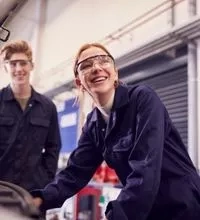Next-gen mobility from the FISITA Technology of Mobility Conference that's changing automotive

If you want to be prepared for the future then it pays to look as far into the horizon as possible. Listen to the experts and find out what is coming down the road.
It’s why events such as the FISITA Technology of Mobility Conference & Exhibition are so important for everyone.
FISITA was established in 1950, and is the international network for automotive engineers, with a reach to over 200,000 engineers in 35 countries. And its CEO Chris Mason is an IMI Non-Executive Director.
This year’s FISITA Technology of Mobility Conference encompassed numerous events, including the FISITA World Congress, World Mobility Summit, Intelligent Safety Conference and Eurobrake. And it was the first time the IMI had attended.
Peter Jackson, the IMI’s International Business Development Manager was at the event, using the event to see what the IMI needs to prepare for in the future, and three aspects stood out from the raft of presentations and papers.
“It was fascinating for horizon scanning for the mid-term. One of them was about Vision Zero, which I naively thought would be about carbon zero, but it isn’t, it’s to do with the removal of fatal accidents from our roads,” he says.
“It’s focus was on how road structures are made so that they deliver the end result of no fatalities and also people use them in the correct way, so if the speed limit is 80km/h, that how it’s used. That way even if there is an accident there will be fewer fatalities.”
It isn’t solely about restricting speeds necessarily and also feeds into other modes of transport. Making bus use safer for example, so when passengers disembark the likelihood of them being hit by other vehicles is reduced.
Fuel development was also highlighted with a presentation by Shell on the use of synthetic and e-fuels to help bring down emissions (not just in road going transport but also in aviation and marine too).
Road to autonomous
One of the biggest subjects at the FISITA event was arguably the future of autonomous technology and the roadmap to fully self-driving vehicles.
“ADAS is a big passion of mine, and we’re at level two autonomy now and aiming for level five, fully-self driving. They announced that ADAS in its current form will only allow us to travel at up to level two autonomy, and things have to change so we can move beyond that,” says Jackson. That means a shift in the industry away from ADAS to Defensive Crash Avoidance Systems (DCAS).
“We aren’t talking next month or next year but potentially in the next 10 years could be the way it goes. Allowing the systems to develop, learn from what we already have in place, to learn what development we’ve already done with camera, radar, lidar and ultrasonic and develop them further,” he says.
But the future isn’t only about technological progress, it’s also about making sure the general public understand what is coming down the line, and are prepared for how to interact with fully self-driving vehicles. That’s something the industry needs to get a handle on and we probably all need to play a part in it.
“There will be a need for the road infrastructure to change. This will reduce the number of vehicles accessing city centres and allow Vision Zero and Carbon Zero to have a better effect on the environment and road safety. Vehicle technology has already started to be used in preparation for this, and raising awareness will hopefully, allow everyone to understand and be more welcoming of it”.
It can be easy to ask why you should pay attention to big conferences, but they play an important role in understanding what the future holds, and allow us to prepare for the changes that’ll come.




